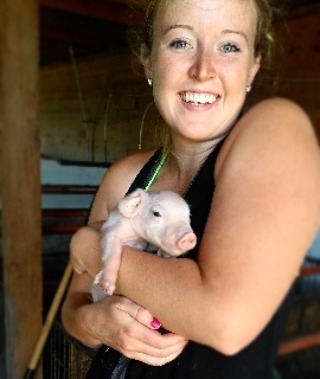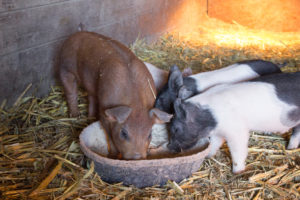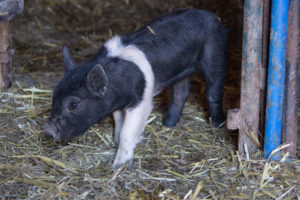From the Farm:
BLOG: Diversifying the Family Farm: Show Pigs and Cover Crops
 Crops, cattle and show pigs…oh my! After graduating from Kansas State University, Caitlyn Horton Willhaus moved back home to help on the family farm north of Kendall, Kansas. Their farm includes 5,000 acres of non-irrigated corn, wheat and milo (sorghum) along with raising cattle and pigs. Horton Show Pigs is a branch of the operation started by Caitlyn in 2016. The business started with two sows (adult female pigs) and has quickly grown to 20 sows with hopes for continued expansion.
Crops, cattle and show pigs…oh my! After graduating from Kansas State University, Caitlyn Horton Willhaus moved back home to help on the family farm north of Kendall, Kansas. Their farm includes 5,000 acres of non-irrigated corn, wheat and milo (sorghum) along with raising cattle and pigs. Horton Show Pigs is a branch of the operation started by Caitlyn in 2016. The business started with two sows (adult female pigs) and has quickly grown to 20 sows with hopes for continued expansion.
Caitlyn and her husband Cooper, raise the pigs for two different purposes; to sell to local 4-Hers to show or for harvesting pork that they sell locally and at farmers markets. On top of their livestock providing a market for the grain their farm produces, Caitlyn also mixes her own feed ration that she sells to the local 4-Hers along with the pigs.
“We grind our own feed here on the farm,” she says, “my dad raises corn and puts it in the bin for us so graciously. We feed a corn and soybean meal based diet and then add additional supplements that pigs need into that.”
 With the help of one of her former professors at K-State, Caitlyn has formulated the feed to meet the nutritional needs of the pigs throughout their life and the different growing stages. After piglets are born they will nurse on their moms for about four weeks before Caitlyn and Cooper wean them.
With the help of one of her former professors at K-State, Caitlyn has formulated the feed to meet the nutritional needs of the pigs throughout their life and the different growing stages. After piglets are born they will nurse on their moms for about four weeks before Caitlyn and Cooper wean them.
“At weaning, about four weeks old, corn begins to get introduced into their diets,” she says, “and they will have corn in their diet all the way up until they are ready to be harvested at the butcher between 270 and 300 pounds.”
Caitlyn is hoping to introduce both her pig and cattle herds to a new food group in their diet this winter. For conservation purposes, they are trying out a wheat, radish and turnip cover crop this winter on some of their ground. Planted in early fall, the radishes and turnips will start growing fast and grow until the ground freezes. Then they will die off and the wheat will continue to grow, providing grazing pasture for both species.
 “We’re just getting into this,” Caitlyn says, “but radishes and turnips grow very long root systems so any tillage compaction you have in the soil they will break it up and help with water infiltration in our fields. We’ve had a lot of really big rains this summer and that has led to issues with runoff and so hopefully we can find a solution for that issue. It is also going to provide food for our cattle and pigs. Everyone tells me cattle love turnips so we’re going to see how it goes.”
“We’re just getting into this,” Caitlyn says, “but radishes and turnips grow very long root systems so any tillage compaction you have in the soil they will break it up and help with water infiltration in our fields. We’ve had a lot of really big rains this summer and that has led to issues with runoff and so hopefully we can find a solution for that issue. It is also going to provide food for our cattle and pigs. Everyone tells me cattle love turnips so we’re going to see how it goes.”
Caitlyn’s father has used no-till practices on his land for more than two decades, but due to increased resistance in weeds he’s had to revert to some tillage the past two years. Pesticides are expensive, says Caitlyn so they don’t want to apply more than necessary and they want to make sure what they apply is actually working and not counterproductive. But tillage hasn’t been a solution for their land either as they have seen negative effects.
“We are just starting out with cover crops,” she says. “Right now we are in a really wet weather pattern so we hope we can utilize it to help our land and feed our livestock. We evaluate every field and plan accordingly each year and there are many different varieties of cover crops to choose from. So we are just figuring it out and one day hope to find the variety that works best for us.”
